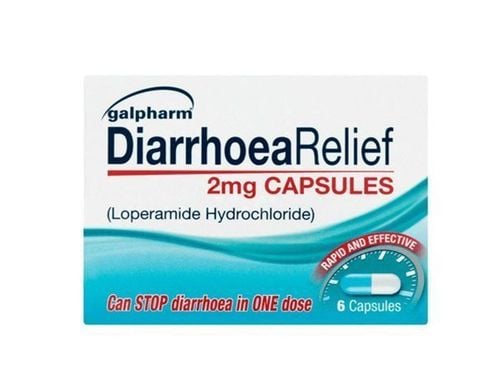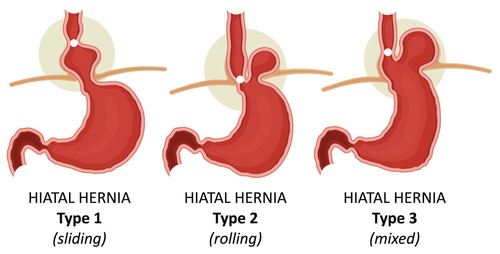This is an automatically translated article.
Posted by Doctor Mai Vien Phuong - Department of Medical Examination & Internal Medicine - Vinmec Central Park International General Hospital.Please follow the series on treatment of diaphragmatic hiatus hernia by Dr. Mai Vien Phuong:
Treatment of diaphragmatic hernia part 1: Medical and surgical treatment Treatment of diaphragmatic hernia part 2: Methods HIS angle shaping method Treatment of diaphragmatic hernia part 3: Robotic surgery and laparoscopic surgery Diaphragmatic hernia is a defect or opening in the diaphragm that allows abdominal organs to move into the chest cavity. A hiatal hernia occurs when the stomach or other organs protrude into the mediastinum through the esophageal opening of the diaphragm.
1. Hernia of the slit diaphragm
The first report on hiatal hernia was published by Bowditch in 1853. In 1926, Akerlund suggested the term "hiatal hernia".In 1919, Angelo Soresi published the first report on the elective surgical treatment of diaphragmatic hernia, entitled: "diaphragmatic hiatus hernia, frequency, diagnosis, basic surgical techniques". The purpose of this article is to call the surgeon's attention to hiatal hernias, especially small hiatal hernias, because patients who suffer from this condition are often treated inappropriately.
Following Soresi's report, many other techniques have evolved. Stuart Harrington et al. at the Mayo Clinic in 1928 reported the treatment experience of 27 cases, with a recurrence rate of 12.5%. This technique is mainly based on the technique of Soresi earlier, especially he emphasized: closing the hernia hole relieves symptoms, when the diaphragm cannot be closed, he will suture the hernia viscera to the abdominal wall. .
In 1970, Nissen's Angleplasty was quickly approved worldwide and became the most popular anti-reflux surgery. The original surgery was modified by Nissen and other surgeons. Closing the hernia is an essential part of anti-reflux surgery. Demeester and Johnson assessed that the most appropriate length of gastric coil is 2 cm, which is sufficient to significantly prevent reflux and reduce symptoms of dysphagia after surgery. It's a variation from Nissen's surgery that is commonly used today.
Currently, there have been many studies in the world showing the effectiveness of surgery in the treatment of diaphragmatic hiatus hernia. These reports specialize in the study of treatment techniques for a certain type of diaphragmatic hernia. In particular, laparoscopic surgery in the treatment of diaphragmatic hernia has been proven by many authors around the world to be feasible, bring good results in terms of aesthetics, reduce postoperative pain and can be performed in Center with experience in laparoscopic surgery.
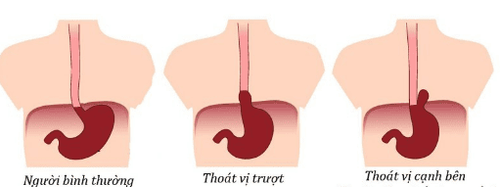
2. Medical treatment
Medical treatment is indicated for symptomatic sliding diaphragmatic hernia. The content of medical treatment is mainly against gastroesophageal reflux - oesophagitis.Treatment against gastroesophageal reflux disease includes: lifestyle changes, reduction of acid secretion and enhancement of gastroesophageal reflux.
Contents of lifestyle changes in the treatment of GERD:
Weight loss (if obese). Avoid eating substances that decrease lower esophageal sphincter tone (alcohol, coffee, lemonade, tomatoes...). Do not eat much in one meal.
3. Surgical treatment
Surgery is indicated in the following cases of diaphragmatic hernia:All cases of type II, III, IV.
Cases of sliding hernia that:
Symptoms do not improve with lifestyle changes and medical treatment. The patient started the disease at a young age and had to undergo long-term medical treatment. In these patients, surgery is considered an alternative to medical therapy rather than a last resort. Complications of type I hernia or of reflux esophagitis, especially spasm, fibrosis, severe ulceration, Barrett's esophagus, gastrointestinal bleeding.
4. Surgical method
Surgery can be performed through the chest or abdomen, by open surgery or laparoscopic surgery.The route of access depends on age, medical condition, elective or emergency surgery, prior surgery, presence of short esophagus.
The thoracic approach is appropriate for patients with obesity, previous upper abdominal surgery, type III diaphragmatic hernia with very short esophagus.
Most cases of hiatal hernia are accessed through the abdomen, through which, the herniated viscera are easily pulled down to the abdomen, and the esophagus is also easier to move.
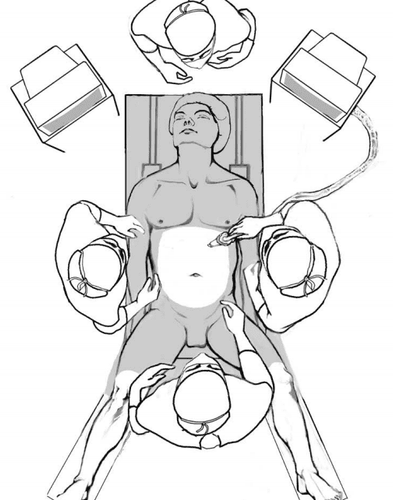
Reveal the surgical field by lifting the liver up and to the side, cutting the hepatic ligament, paying attention to preserving the anterior X nerve.
Step 2: insert the hernia components to be gently pulled into the abdominal cavity.
Step 3: The entire hernia sac is dissected from the margin of the hernia hole and completely out of the mediastinum before being resected.
Step 4: expose the right and left pillars of the diaphragm:
The right pillar of the diaphragm is pulled to the side, the right side of the esophagus is carefully dissected to clearly see the aortic and nerve esophageal fis wandering behind. The left cast is similarly dissected from the esophagus and fundus to its origin from the right pillar.
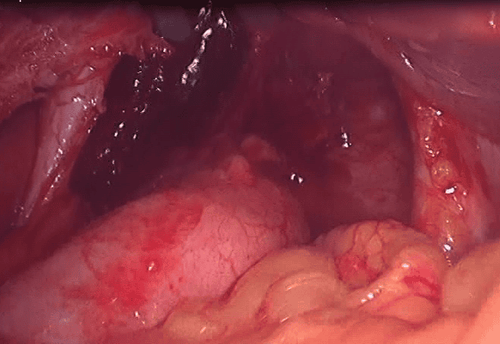
Complete esophageal motility before hernia defect repair. The gastroesophageal junction should be positioned at least 3 cm below the hernia opening so as not to stretch.
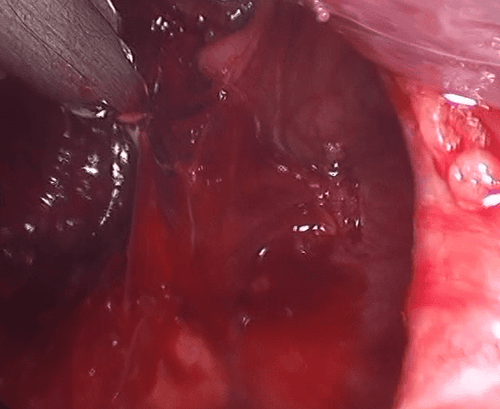
Diaphragm hole is sutured with 2 or 3 stitches of 1/0 or 2/0, undissolved, round needle, loose stitch, can use Ethibon, Prolen or Silk thread.
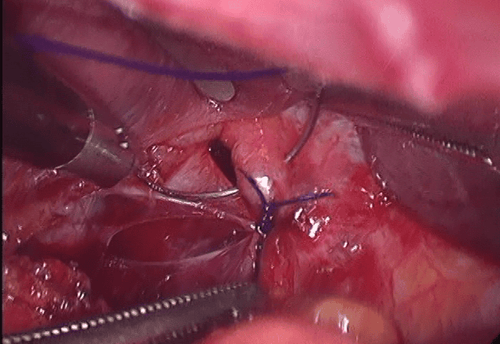
The right border of the fundus is sutured to the left border of the esophagus, the anterior surface of the fundus is sutured to the right border of the esophagus. The fixed suture between the small curvature of the stomach and the fundus is folded.
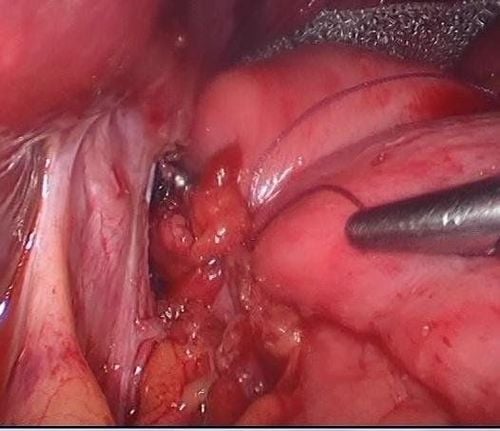
For the case of large hernia hole, we use a piece of about 7 x 10 cm U-shaped put into the diaphragm after stitching the two diaphragms. The graft is fixed to the diaphragm with removable sutures or clips.
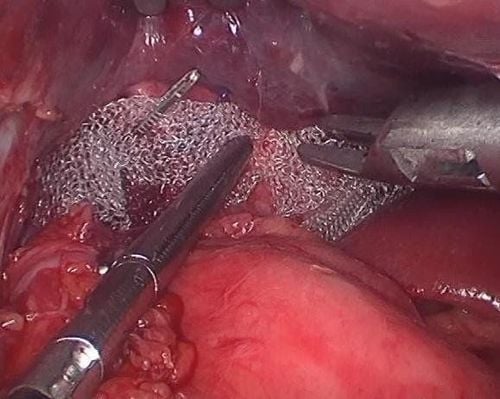
Vinmec International General Hospital is a prestigious address trusted by many patients in performing diagnostic and treatment techniques for diaphragmatic hernias... Along with that, At Vinmec Hospital, diagnostic endoscopy is performed through gastroscopy with Olympus CV 190 endoscope, with NBI (Narrow Banding Imaging) function for imaging results. mucosal pathology analysis is clearer than conventional endoscopy, detecting small hernia lesions. Vinmec Hospital with modern facilities and equipment and a team of experienced experts who are always dedicated in medical examination and treatment, customers can rest assured with gastroscopy and esophagoscopy services at Vinmec Hospital. Vinmec International General Hospital.
Please dial HOTLINE for more information or register for an appointment HERE. Download MyVinmec app to make appointments faster and to manage your bookings easily.









